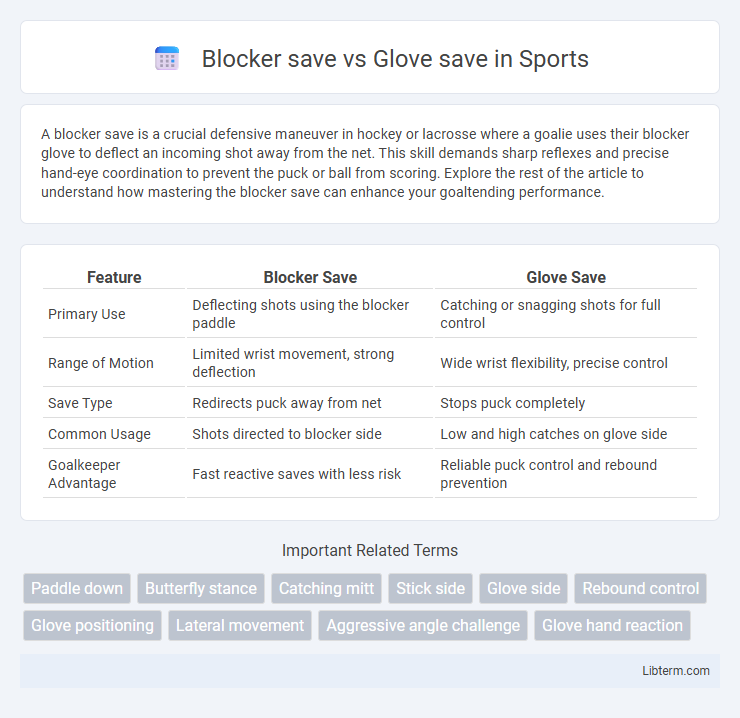A blocker save is a crucial defensive maneuver in hockey or lacrosse where a goalie uses their blocker glove to deflect an incoming shot away from the net. This skill demands sharp reflexes and precise hand-eye coordination to prevent the puck or ball from scoring. Explore the rest of the article to understand how mastering the blocker save can enhance your goaltending performance.
Table of Comparison
| Feature | Blocker Save | Glove Save |
|---|---|---|
| Primary Use | Deflecting shots using the blocker paddle | Catching or snagging shots for full control |
| Range of Motion | Limited wrist movement, strong deflection | Wide wrist flexibility, precise control |
| Save Type | Redirects puck away from net | Stops puck completely |
| Common Usage | Shots directed to blocker side | Low and high catches on glove side |
| Goalkeeper Advantage | Fast reactive saves with less risk | Reliable puck control and rebound prevention |
Introduction to Hockey Saves: Blocker vs Glove
Blocker save and glove save are fundamental techniques in hockey goaltending that serve to stop pucks with different areas of the goalie's equipment. A blocker save utilizes the rectangular, padded blocker worn on the dominant hand to deflect shots away from the net, emphasizing control and redirection. The glove save relies on the catching glove on the non-dominant hand to securely catch and hold the puck, providing a more controlled stoppage and potential for quick puck handling.
Anatomy and Function of the Blocker
The blocker features a rectangular padded surface worn on the dominant hand, designed to deflect pucks away from the net while allowing precise control and maneuverability during saves. Its rigid backhand protection and flexible wrist section enable quick hand movements and effective puck redirection without compromising safety. Unlike the glove save, which relies on a catching pocket, the blocker focuses on angled deflections using its reinforced palm and board-like face to minimize rebound risk and maintain puck control.
Anatomy and Function of the Glove
The glove in ice hockey goaltending is anatomically designed with a webbing pocket between the thumb and index finger, enabling a wide, flexible catching surface to trap pucks effectively. Its function centers on absorbing impact and providing dexterity to snatch high-velocity shots away from the net, enhancing save control and rebound management. In contrast, the blocker focuses on deflecting pucks using a rigid rectangular pad worn on the hand, prioritizing redirection over capture.
Key Differences Between Blocker Saves and Glove Saves
Blocker saves rely on the rectangular blocker pad held in one hand to deflect shots, providing a larger surface area for redirecting pucks away from the net with controlled, directional movements. Glove saves use a catching glove designed for quick reflexes and snatching pucks mid-air, emphasizing precision and hand-eye coordination to trap the puck securely. The key difference lies in the technique and equipment: blocker saves focus on pushing or deflecting shots, while glove saves prioritize catching and immobilizing the puck.
Situational Effectiveness: When to Use Blocker or Glove
Blocker saves are most effective in situations where the shooter targets angles close to the ice or boards, allowing goalies to deflect pucks away from high-danger scoring areas using the flat surface of the blocker. Glove saves excel when facing shots aimed higher or requiring quick, reactive catches to prevent rebounds and maintain puck control, especially during breakaways or tight one-on-one plays. Choosing between blocker and glove saves depends on shot trajectory, game context, and positioning, optimizing save success by responding to puck placement and shooter tendencies.
Technique Breakdown: Executing a Blocker Save
Executing a Blocker save requires precise positioning of the blocker pad to deflect shots away from the net with controlled redirection. The technique emphasizes an active wrist snap combined with angling the blocker squarely toward the puck to maximize rebound control and minimize scoring chances. Proper weight distribution on the legs allows the goalie to maintain balance while swiftly adjusting the blocker to intercept high-velocity shots.
Technique Breakdown: Executing a Glove Save
Executing a glove save requires precise hand positioning, rapid wrist snap, and keen eye tracking to catch or parry the puck with the glove hand. Goalkeepers extend their glove hand outward and slightly upwards to create a larger catching area, relying on soft grip and flexible fingers to cradle the puck securely. Proper glove saves emphasize timing and reflexes, with wrist flexion and opening of the glove to absorb shooting velocity and redirect the puck away from the net.
Common Mistakes with Blocker and Glove Saves
Common mistakes with blocker saves often include improper positioning, leading to blocked rebounds that easily fall to opponents, and a failure to angle the blocker to effectively seal off shooting angles. Glove save errors frequently stem from slow hand movement and poor timing, which cause the goalie to miss high shots or let the puck slip through the fingers. Both techniques require precise hand-eye coordination and consistent practice to minimize reaction errors and improve save success rates.
Training Drills for Enhancing Blocker and Glove Skills
Training drills for enhancing blocker saves focus on improving hand-eye coordination through rapid reaction exercises and lateral movement drills that simulate puck deflections near the net. Glove save training emphasizes agility and precision, utilizing high-repetition catching drills and reaction ball exercises to develop swift glove hand responsiveness. Incorporating both blocker and glove-specific drills into practice routines significantly increases a goaltender's overall save percentage and in-game performance.
Impact on Game Outcomes: Blocker vs Glove Saves
Blocker saves allow goalies to quickly deflect high-velocity shots along the ice, maintaining puck control and enabling rapid counterattacks, which can shift game momentum. Glove saves provide a broader catching surface to fully trap the puck, reducing rebound chances and increasing defensive stability during critical plays. Teams benefit strategically by balancing blocker saves for redirecting shots and glove saves for securing possession, directly influencing save percentage and game outcomes.
Blocker save Infographic

 libterm.com
libterm.com